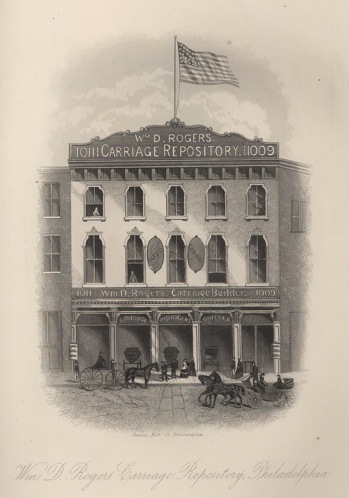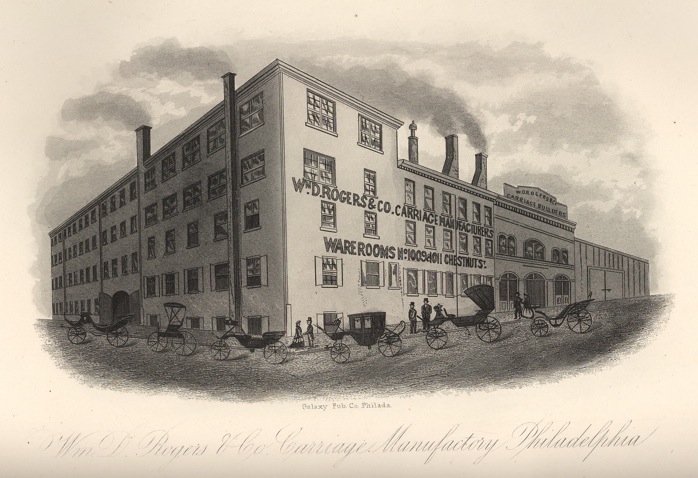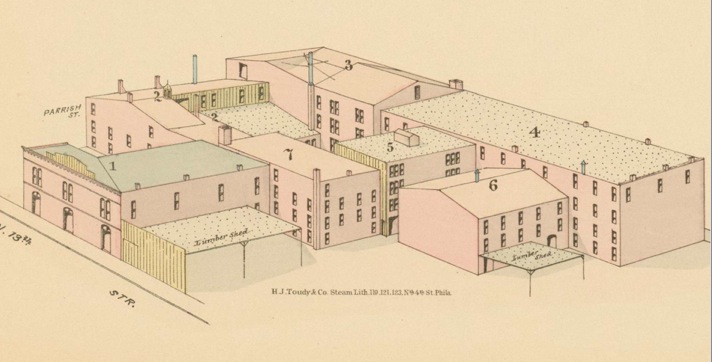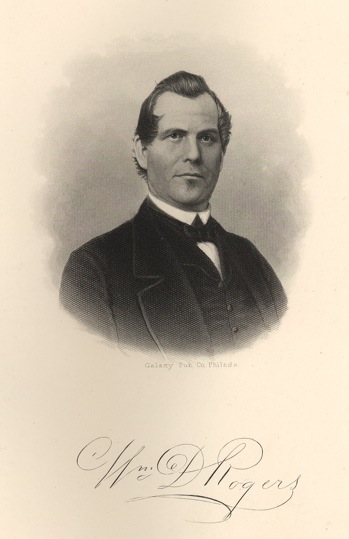
WILLIAM D. ROGERS' CARRIAGE REPOSITORY AND FACTORY
1109-1111 Chestnut Street, Philadelphia, PA.
—Charles Robson, Manufactories & Manufacturers of Pennsylvania (Galaxy, 1875), pp. 296-7.
Nearly thirty years ago, in the year 1846, the proprietor of this establishment began business on his own account, in a small building—part of the Girard Estate—on the corner of Sixth and Brown streets. He was only a young man, but possessed a thorough knowledge of his trade. During the first year he employed ten hands, and two years later this number had increased to fifty. Under his good management, and by untiring industry on his own part, business grew apace; and such temporary improvements as the precarious tenure of the lease would justify were added from time to time, to meet the growing demand, until, in 1833, he built the factory at Sixth and Master streets. It covered a space of 172 by 137 feet, was four stories high, thoroughly fitted up with every modern appliance, and at the time was regarded as the model coach factory of America. Up to this period his office and salesrooms had been at his factory; but, for the better accommodation of his down-town trade and to reach transient custom, he decided to fit up and open a salesroom and repository on Chestnut street.
This was accomplished in 1857, and the present magnificent bazaar, Nos. 1009 and 1011 Chestnut street, is the result. A few years later it was found of the highest importance to connect the factory with the offices and repository, so that all ordered work could be done under his direct supervision, his business having by this time grown largely into a custom trade. Accordingly, in 1860, the rear portion of the repository was rebuilt and fitted up for workshops. His career had been a most prosperous one, and his vehicles had been sought for not only by the citizens of this and other States, but France, England, Germany, Italy and Switzerland had become familiar with his name.
But the day of adversity came; for at the outbreak of the great rebellion, in 1861, he lost heavily through filling large orders from the South. He met misfortune bravely, and immediately arranged for the unreserved sale of all his real and personal estate. His creditors, sixty in number, gave him a written and unconditional release; and many of his friends, more fortunate than himself, came forward with offers of pecuniary help, he, however, declined these kindly propositions, and bravely began the world for the second time. When the auction sale took place, in order that the contents of the factory might not be sacrificed, a creditors' fund was established, and most of time unfinished work, tools and appliances were bought in; and he pledged himself to work for the fund, at a salary, for six months. At the end of that period the stockholders received 70-1/2 per cent. on their investment. They then transferred the tools, machinery and unfinished work yet remaining to him, with the understanding that payment for the same was to he made at his own time and convenience. With this property and $83 cash capital, he went to work again with renewed hope and energy.
Prostrated by the first shock of disaster, and for some time confined to his bed by illness, he put forth all his energies, fully discharged his obligations (over $60,000), completely re-established his business, repaired his broken fortunes, and his standing in the mercantile community became higher than before. Having suffered from the credit, he changed his policy to the cash system. In 1865, he added to his workshop a large four story brick building, on Filbert street, where the rough lumber is stored and seasoned, and which also serves as a workshop for the wood-work and heavy forging. A very heavy stock of lumber is required to be kept constantly on hand , as the seasoning requires not months, but years; and all lumber for first-class work, which is the only class manufactured at this establishment, needs from two to five years to perfect it. The woods used for bodies are ash, cherry and poplar; for the wheels and running gear, hickory. The iron used in the smith shop, where the heavier class of carriages are ironed, as well as in all the smith shops of this establishment is of Norway, Ulster and Lowmoor brands, experience having demonstrated these to be the best adapted to this branch of manufacture. In the manufacture of the wheel, every attention is paid to the production of a first-class article ; and so very particular is the proprietor in this respect that one and the same man has driven every spoke that has been used in the factory for nearly twenty-five years, which of itself is a sufficient recommendation. All the leather used for trimming time carriages is made expressly for the establishment; while the cloths, silks, carpets, etc., are for the most part imported. All the work is done by hand.
An amusing incident is related in connection with a light buggy shipped to an American Consul in Switzerland, several years ago. The astonished natives looked at it with curious interest, and predicted that its skeleton frame-work would be jolted to pieces on the mountain roads of the Swiss Alps. The purchaser was absent when the vehicle arrived, and his servant (he must have been a Yankee) charged an admission fee to those desiring to inspect it. His enterprise brought him a considerable sum in money—more than he would have earned in six months! In 1870, the proprietor leased the factory formerly in the occupancy of George W. Watson & Co., in the same business; and in 1871 took into partnership Joseph Moore, Jr., and thoroughly re-organized its various departments, to fulfil the growing demands of the trade.

The great success which has attended the proprietor of this manufactory may be ascribed to his early determination to secure excellence in detail. This plan was adopted and strictly adhered to. He has never catered for a ''cheap '' class of work; and his patrons are among that class of economists who understand that a higher price paid for an article at the outset will secure for them a first-class article, which will prove the cheapest in the long run and will save them many times the additional amount in interest and repairs. A few words will serve to explain the secret of success of this house. Striving not so much to exceed in the volume as to excel in the quality of the work produced; not so much the number of patrons as their selection, it has acquired a reputation and consequent success, which life is too short to lose.
See also:
William D. Rogers & Co. Carriage Works, 13th & Parrish Streets, Hexamer # 486 (c. 1871)

William D. Rogers & Co. Carriage Works, 13th & Parrish Streets, Hexamer # 1237 (1878)
-----

WILLIAM D. ROGERS was born, July 16th, 1819, at Baltimore, Maryland. At the age of fifteen he was regularly indentured, in Philadelphia, to the carriage building business. After his apprenticeship had expired he began to travel, with a view to perfecting himself in his business and to obtaining a thorough knowledge of the wants of the trade in all parts of the New World. He worked as a mechanic, under the most skilful builders, in various cities and towns of New England, the Southern States, Canada and the West Indies. His pet idea had always been to start a first-class coach manufactory in Philadelphia.
Returning to that city, therefore, with the stock of knowledge he had obtained in travel, which was probably greater than that of any young mechanic in the business at that day, he invested his little savings in carriage building of the finer class. He now found use for the knowledge he had gained, and was able to speak advisedly on everything connected with his business, North, South, East and West. Connoisseurs soon began to appreciate this, and the very best patronage of the country became his. Added to his natural ability as a mechanic, he was a very tasteful designer, and made his manufactures in this respect an example to be followed by others. His great success was not achieved without a hard struggle, but it was worth all he had endured to achieve it. His honorable ambition has ever been, not to equal, but to excel in everything connected with his manufactures, and his business rivalry has always been characterized by a generosity that has won the admiration of his fellow-manufacturers.
Among carriage-builders he is very popular, from his accommodating disposition and the kindly interest he takes in everything looking to the establishing of a fellowship amongst them. He is so far in advance of most of them, and is so continually putting something new and tasteful into the market, that they look upon him more as a conservator of the art in their business than a a formidable competitor. But one in each trade, art, or profession can excel, and it is generally conceded that William D. Rogers has succeeded in reaching the top round of the ladder in his. He has made his business world-famous, and has become an authority upon all matters connected with the finer class of carriage building. In personal appearance, he is about the medium height, with a well-built frame, whose roundness is well preserved in spite of the severe tax to which it has been subjected during the many years of his very active business life. In his face there is a record of no vices, but it is characterized by a geniality and frankness of expression that wins upon friend and stranger alike, and puts them perfectly at ease in his company. In his intercourse with his workmen, he so conducts himself as to secure their confidence; and some of his fellow-workmen are new in his employ, while those who have served an apprenticeship in his establishment are anxious to continue as journeymen in the same.